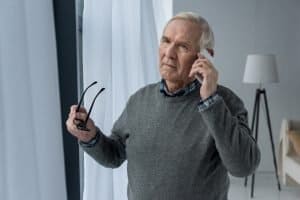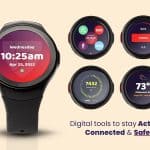
Many older adults live with a fixed income and for some, that fixed income is quite low. In fact, an estimated 7.2 million seniors live in poverty, which can be stressful for both the older adult and their loved ones. Fortunately, there are programs that are specifically for older adults with limited income, including the Lifeline program.
Developed in 1985, the Lifeline program has offered discounted rates for phone services for qualifying seniors. You can read their full company profile on our Lifeline review. When it was first rolled out, senior advocates and experts noted that without a phone, seniors could not connect with family members or friends. Phones were also a way to call for emergency assistance and connect to jobs or other opportunities. Because phones were a necessity, the Lifeline program offered discounts so that low-income seniors could have a phone in their homes.
Nowadays, the necessity isn’t just a landline phone. In fact, many of us no longer have landline phones at all. We connect with friends and family over cell phones as well as the internet. In 2016, the Lifeline program was adjusted to meet modern ways of communicating.
Today, low-income seniors who qualify for Lifeline can get broadband services as well as voice services. Thanks to Lifeline, low-income seniors can keep with the world and have access to emergency services without compromising their fixed budgets.
Here’s everything you need to know about the Lifeline program.
How Lifeline Works
The Lifeline program provides a monthly discount to eligible subscribers. Currently, eligible low-income seniors can receive a discount of up to $9.25 per month. For eligible subscribers who live on Tribal Lands, the maximum discount is $34.25.
Currently, subscribers get to choose what type of service they would like a discount on: wired or wireless services. The subscriber may choose to use their discount for broadband, or wireless bundles too.
In order for the monthly discount to be applied to the subscriber’s account, the low-income senior must meet eligibility requirements and recertify annually. They must also meet the rules of the program and use providers that work with the Lifeline program.
Eligibility is determined by income. Lifeline program participants must certify that their income is at or below 135% of the guidelines set forth by the Health and Human Services department. These guidelines change annually and are updated on the ASPE website annually as well.
Sometimes, low-income seniors are told they qualify for the Lifeline program because they are enrolled in other federal assistance programs. For example, people who participate in the Supplemental Nutrition Assistance Program, or SNAP, may also be eligible for Lifeline benefits. Other federal programs that could indicate eligibility for Lifeline participation can include SSI, Medicaid, Housing Assistance, VA Pension Benefits, or certain Tribal Programs.
National Verifier for Lifeline Eligibility
In order to qualify for Lifeline discounts, low-income seniors must meet eligibility requirements. The first step in determining your eligibility, as well as the first step in receiving your Lifeline program discounts, is to head to the National Verifier application system website.
This website was established by the Federal Communications Commission and gives people a place to determine eligibility for the program as well as for recertifying annually.
When you visit the website, you are able to enter the requested information and create an account. This way, if you are eligible, you will use the account information to recertify your discounts annually as well as to choose a phone and/or internet provider that is local to your area.
If you do not have all the information required when you complete your eligibility screener, it’s okay. Your information is stored in your account so you can log out to get the other paperwork you need to finish the application. You have 45 days to finish up the Lifeline program application once you begin it.
If the person applying lives in California, Texas, or Oregon, they must apply for Lifeline program discounts through the state’s application system. While the Lifeline program is a federal program, these three states have application processes that run through the state.
You can also request a paper application be mailed to you if you are unable to complete the information on the website.
Program Rules

It is easy to apply online or to check your eligibility for the Lifeline program.
As with any federal or state assistance program, there are rules to ensure eligibility and continued eligibility from year to year. Fortunately, the rules for the Lifeline program are not complex or difficult to understand. Here are the regulations and guidelines that you or your senior loved one should be aware of:
- All Lifeline subscribers must meet eligibility requirements. They certify that they meet the requirements by applying via the National Verifier website or via a requested paper application.
- Lifeline subscribers must recertify annually. Currently, there is an extension for recertifications because of the coronavirus pandemic. However, annual recertification is still required.
- Lifeline discounts apply only to one household. This means if there are two low-income qualifying seniors in the home, there can only be one Lifeline discount.
- If there are two Lifeline subscribers who move in together, one must de-enroll from the program immediately.
- Applicants must be honest with their application and recertification efforts.
- Lifeline benefits are not transferable. This means that you cannot pass your benefits on to someone else.
Lifeline Providers
The federal government works with eligible telecommunications carriers or ETCs. There are certain ETCs that are Lifeline providers. Currently, the Federal Communications Commission does not allow states to designate ETCs as Lifeline Broadband Providers or LBPs.
While the program is federal, the states do have a role in the program. States are in charge of developing and managing any applicable state programs as well as designating non-LBP ETCs. States are also responsible for the protection of the consumers and providing oversight to Lifeline ETCs as necessary.
There are many providers that qualify as eligible telecommunications carriers. You can find a comprehensive list when applying for the Lifeline program.
Find a Company
If you are curious if you can work with your preferred voice or internet service provider while still receiving a Lifeline program discount, you can check your company through the data.usac.org website. You simply have to put in your zip code or your city and state. Then, the website will generate companies that provide service in your area that are also qualified eligible telecommunications carriers with the ability to provide the Lifeline discount.
FAQs
The Lifeline program provides discounts for qualifying low-income seniors across the country. While the application process is generally easy compared to other government programs, there can still be some confusion when it comes to the ins and outs of the program.
Here are some of the most commonly asked questions, along with the answers that can point you in the right direction.
How much money does the Lifeline discount save me each month?
Currently, the Lifeline program gives eligible, low-income seniors up to $9.25 per month in a discount for their services. Those eligible who also live on Tribal Lands are able to receive an additional $25 per month as a discount for services. This bring the potential discount total for those living on Tribal Lands to $34.25.
What services are covered in the Lifeline program discount?
Eligible Lifeline subscribers can put their discount toward services that include wired or wireless telephone services, broadband internet services, or a bundle.
Am I considered eligible or low-income?
Perhaps the most confusing part of the Lifeline program is simply knowing if you would qualify for discounted services. You can find more information about qualifications by visiting the Lifeline Support website. In general, though, you might be eligible if you:
- Have an income that is at or below 135% of the federal poverty guidelines. These guidelines change yearly and are updated here.
- You currently receive benefits from other government programs such as the Supplemental Nutrition Assistance Program (this is also called SNAP and was once referred to as Food Stamps), Medicaid, VA Pension Benefits, SSI, or if you are eligible for public housing assistance.
Where can I express my interest in the program or apply for services?
You can apply online by visiting the National Verifier online portal. You can start an account and application. You have 45 days to complete your application after you begin it. Your account will also be helpful for recertification and other communications about the program.
If you are more comfortable with a paper application, you can request one on the National Verifier website.
Do I need to prepare certain information in order to apply?
You do need to provide certain information and documentation in order to apply for the Lifeline discounts. If you begin your application and do not have all the information you need to complete it, you can log off and return within 45 days with the information to complete your application.
Depending on your eligibility in regards to SNAP or Medicaid, you might need to provide information such as notice of participating in a qualifying program. You will also need to verify your income through tax returns, paycheck stub documentation, SSI statements, VA statements, or unemployment benefit documentation.
My wife and I both are considered low-income. Can we get two discounts monthly?
No. There is only one Lifeline program discount allowed per household. There are penalties for households that currently receive two discounts.
If you happen to move in with someone else who also has a discount, one of you must unenroll from the Lifeline program.
If you live in a group living facility however, there are exceptions to the rule. You will need to demonstrate when enrolling that you are a part of a group living facility by completing a special worksheet. This will be given to you should you need it during the application process.
What if I don’t know how to renew my eligibility for the Lifeline program?
You must recertify your eligibility annually. You can do this on the National Verifier website, with your account that you set up during your application process. You will be notified when your certification time is approaching, but it is wise to also put it in your calendar so you remember to take care of it promptly in order to not interrupt your discounts or status in the program.
Do Lifeline discounts apply to my internet service?
Yes, if you want it to. Your discount can be applied to wired or wireless telephone service, broadband internet service, or a bundled service.
Do Lifeline discounts apply to my cell phone?
Yes, if you want it to. You can apply your monthly discount to billed services that include wired or wireless telephone service, broadband internet service, or a bundled service.
Can I use my preferred provider and still receive the Lifeline discount?
Perhaps. You can check your local providers by the data.usac.org website. You can type in your zip code or your city and state in order to find local providers near you that work with the Lifeline discount.
What if I have problems with my service?
The Lifeline program provides discounts to qualified, low-income individuals. The Lifeline program does not take care of any service-related issues. If you have any questions about service or concerns, contact your service provider directly. They can help you resolve the issue.
Where do I go if I need assistance applying for Lifeline because of a disability?
You can get help from the Lifeline Support Center by calling 1-800-243-9473. You can also get support by visiting LifelineSupport.org. The representatives there can assist you in applying for services, answering your questions, or pointing you in the right direction.
If you are concerned because your Lifeline service or equipment is not accessible, call the Federal Communications Commission’s Disability Rights office. You can reach them at 1-202-418-2517. If you need a videophone call, use the number 1-844-432-2275. There is also an email to support personnel at [email protected].
Does the Philips Lifeline Medical Alert System Qualify?
The Lifeline program that offers discounts to low-income, qualified seniors is not the same thing as the Philips Lifeline Medical Alert System. These two entities, while sharing a similar name and serving similar populations, are not related.
The Philips Lifeline Medical Alert System is an emergency response system that includes an emergency call button typically worn on a pendant. When the emergency button is pressed, the senior is redirected to a Response Center, which is staffed around-the-clock. The trained specialist who receives the call then assists the senior, as needed, and can even dial emergency services to dispatch them to the senior’s location.
Philips Lifeline Medical Alert System provides a variety of products for seniors and their family members. These products include systems that are based in the home as well as mobile devices.
Medical alert systems typically charge for the initial setup and products as well as a monthly fee. Currently, Medicare does not pay for these services or products through Part A or Part B benefits. Part C or private insurance may defray some of the costs for an emergency response system.
When it comes to Medicaid, there is a possibility that your benefits could cover some of the costs associated with emergency response systems like the Philips Lifeline Medical Alert system. Some Home and Community Based Services programs offer waivers that could be used toward emergency response system fees. Check with your caseworker to review your benefits and goals.
The Lifeline program to subsidize monthly fees that go to services such as wired or wireless telephone service, broadband or internet service, or a bundled package of service is an excellent option for keeping low-income seniors connected to others. The Philips Lifeline Medical Alert System is an excellent option for keeping seniors safe at home.


